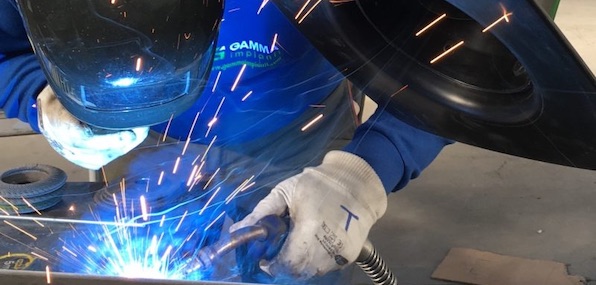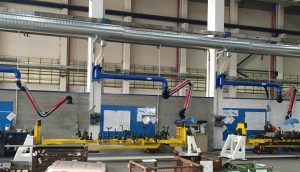
Welding fumes are dangerous because they arise from a combustion where the objects to be welded are brought to temperatures close to that of melting, in order to form the welding seam. During this phase welding fumes are released, which depending on the type of processing and metals can also be carcinogenic.

Leaving aside the description of welding techniques that you will certainly know if you have come across in these pages, we will focus on the techniques of extraction and purification of fumes in particular on those defined located at the source as required by the legislator and recommended by good plant engineering technique.
In welding work of MIG stainless steel or continuous wire, welding fumes and micro-dust often contain particles of chromium, manganese and nickel inside.
The most dangerous, if inhaled, are the chrome ones.
In particular, the hexavalent form of chromium, present in several compounds of industrial origin “on the basis of experimental and epidemiological evidence has been classified by the IARC as a carcinogen for humans (class I)”.
We conclude this paragraph a little terrorist remembering that most of the harmful substances and particulates contained in welding fumes measure at source 0,01÷0.1 microns, this means that they are easily inhaled and can penetrate into the lungs and even, if with prolonged exposure, into the blood.
Also the Italian legislator obviously deals with the subject and does it in a very precise way in spite of those who think that there are no directives for this type of pollutants produced by such widespread processing in mechanical workshops.
The obligations and preventive measures provided for in Legislative Decree no. 81/2008 are those of reference for welding fumes, in particular since in this article we deal with the subject, we point out what is indicated in Annex IV.
“Requirements of the workplace”:
2.1.5. The extraction of gases, vapours, odours or fumes, as far as possible, must take place immediately near the place where they are produced.
The technology applied to the development of safety equipment and filtration systems in recent years has greatly simplified the work of technicians who are sizing plants or systems for suction and purification of welding fumes.
Compared to the 70s and 80s, in fact, the technical approach to this type of suction has increasingly seen the use of suction arms or flexible pipes at the expense of “hoods and capons” that were typically installed above the operator’s head resulting in pre-inhalation of fumes even before they were aspirated.
This product as we said has for many years the monopoly of localized or close solutions because thanks to its “self-lift” or the ability to remain suspended in mid-air, it can be placed very, very close to the emission of fumes and when connected to a properly sized suction system ensures the protection of the respiratory tract by sucking almost all the fumes produced, as can be seen from the video below, made at a metal carpentry.
On the other hand, it forces the operators to continuous movements of the extractor hood so that it is always close to the source otherwise it completely loses its effectiveness as the localized aspiration uses much less air flow than the classical systems.
And after the arm? Mobile purifier or centralized plant
Once you have reached the certainty that the suction arm is the best solution for welding fumes, it remains to be defined where or better to what to connect it and in this case there are two main solutions:
1) Mounted on board a trolley or mobile purifier for welding fumes, a typically successful solution when there is no well-defined layout or the details are difficult to reach with fixed arms.
Recent construction techniques and development have brought this solution to concrete levels of safety, reaching filtration efficiencies of 99.9% classified W3 by German regulations or suitable for inhaling and filtering carcinogens.
In the video below you can appreciate this type of purifier in action.
2) Installed on the wall or along a centralized smoke suction system, perhaps with several arms connected to extensions and a collector, a fan, and an external filter as is typically the case in the suction systems.

3) Mounted on a fixed hanging welding fume purifier which is then normally positioned on the wall or on a column, close to the welding fume producing station and which, thanks to the built-in fan, as seen from the video below, it quickly sucks welding fumes from the self-supporting arm and then purified to 99.9% efficiency with 3 different filtration stages.
In the next articles we will cover in depth these two solutions.
Secure air – technical Department
Fill in the form below to request a quote by email, agree on special conditions, or technical clarifications